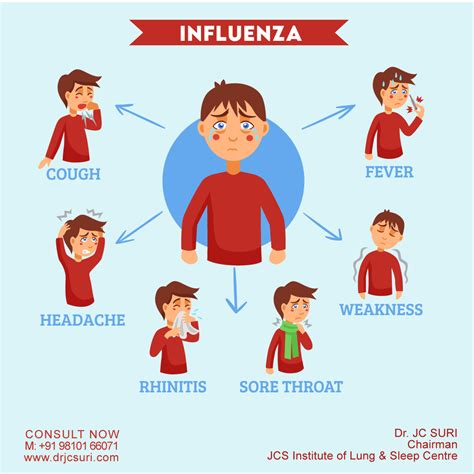Intro
Identify 7 key influenza symptoms, including fever, cough, and fatigue, to recognize the flu virus and seek timely treatment, alleviating respiratory issues and preventing complications.
Influenza, commonly known as the flu, is a highly contagious respiratory illness caused by the influenza virus. It can affect anyone, regardless of age or health status, and its symptoms can range from mild to severe. Understanding the symptoms of influenza is crucial for early detection, treatment, and prevention of complications. In this article, we will delve into the 7 common influenza symptoms, their severity, and what you can do to manage them.
The flu season typically starts in the fall and peaks during the winter months, but it can occur at any time of the year. The Centers for Disease Control and Prevention (CDC) estimates that influenza affects millions of people in the United States each year, resulting in thousands of hospitalizations and deaths. The economic burden of influenza is also significant, with billions of dollars spent on medical care, lost productivity, and other related costs.
Influenza symptoms can be similar to those of the common cold, but they are usually more severe and can lead to serious complications, such as pneumonia, bronchitis, and sinus infections. If you are experiencing any of the following symptoms, it is essential to seek medical attention promptly to prevent long-term health consequences.
Influenza Symptoms Overview

High Fever

Managing High Fever
To manage a high fever, you can try the following: * Take over-the-counter medications, such as acetaminophen or ibuprofen, to reduce the fever and alleviate associated symptoms like headache and body aches. * Stay hydrated by drinking plenty of fluids, such as water, clear broth, or electrolyte-rich beverages like sports drinks. * Rest and avoid strenuous activities to help your body recover from the illness. * Use a cool compress or take a cool bath to bring down the body temperature.Chills

Managing Chills
To manage chills, you can try the following: * Take a warm bath or shower to relax and increase blood flow. * Use a heating pad or a warm compress to apply heat to the affected area. * Drink warm beverages, such as tea or hot chocolate, to help raise your body temperature. * Wear warm clothing, such as a blanket or a sweater, to stay cozy.Cough

Managing Cough
To manage a cough, you can try the following: * Use a humidifier to add moisture to the air and relieve a dry cough. * Take over-the-counter medications, such as cough suppressants or expectorants, to reduce the frequency and severity of the cough. * Stay hydrated by drinking plenty of fluids to thin out mucus and make it easier to cough up. * Avoid irritants, such as smoke or strong fumes, that can exacerbate the cough.Sore Throat

Managing Sore Throat
To manage a sore throat, you can try the following: * Gargle with salt water several times a day to reduce inflammation and kill bacteria. * Take over-the-counter medications, such as pain relievers or throat lozenges, to reduce pain and discomfort. * Stay hydrated by drinking plenty of fluids to keep the throat moist and reduce irritation. * Avoid irritants, such as smoke or strong fumes, that can exacerbate the sore throat.Runny or Stuffy Nose

Managing Runny or Stuffy Nose
To manage a runny or stuffy nose, you can try the following: * Use saline nasal sprays or drops to moisturize the nasal passages and loosen mucus. * Take over-the-counter medications, such as decongestants or antihistamines, to reduce congestion and relieve sinus pressure. * Stay hydrated by drinking plenty of fluids to thin out mucus and make it easier to expel. * Avoid irritants, such as smoke or strong fumes, that can exacerbate the congestion and sinus pressure.Headache

Managing Headache
To manage a headache, you can try the following: * Take over-the-counter medications, such as pain relievers or anti-inflammatory medications, to reduce pain and inflammation. * Stay hydrated by drinking plenty of fluids to prevent dehydration and reduce headache severity. * Rest and avoid strenuous activities to help your body recover from the illness. * Apply a cool or warm compress to the forehead or neck to relieve tension and reduce pain.Fatigue

Managing Fatigue
To manage fatigue, you can try the following: * Rest and avoid strenuous activities to help your body recover from the illness. * Stay hydrated by drinking plenty of fluids to prevent dehydration and reduce fatigue severity. * Take over-the-counter medications, such as energy supplements or vitamins, to boost energy levels and reduce fatigue. * Prioritize sleep and aim for 8-10 hours of sleep per night to help your body recover from the illness.What are the most common symptoms of influenza?
+The most common symptoms of influenza are high fever, chills, cough, sore throat, runny or stuffy nose, headache, and fatigue.
How can I manage influenza symptoms at home?
+You can manage influenza symptoms at home by staying hydrated, resting, taking over-the-counter medications, and using a humidifier to add moisture to the air.
When should I seek medical attention for influenza symptoms?
+You should seek medical attention for influenza symptoms if you experience difficulty breathing, chest pain, severe headache, or if your symptoms worsen over time.
Can I prevent influenza by getting vaccinated?
+Yes, getting vaccinated is the best way to prevent influenza. The flu vaccine is available each year and can be administered by a healthcare professional.
How long does it take to recover from influenza?
+The recovery time for influenza can vary from person to person, but most people can recover within 1-2 weeks with rest, hydration, and proper medical care.
In conclusion, understanding the 7 common influenza symptoms is crucial for early detection, treatment, and prevention of complications. If you are experiencing any of these symptoms, it is essential to seek medical attention promptly to prevent long-term health consequences. By staying informed and taking the necessary precautions, you can protect yourself and your loved ones from the flu and stay healthy throughout the year. We encourage you to share this article with your friends and family to help spread awareness about influenza symptoms and prevention. If you have any questions or comments, please feel free to leave them below.
